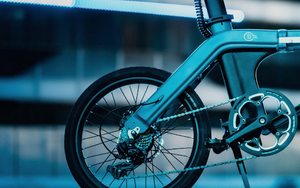Are Electric Bikes Good for Exercise?
Sep 03, 2024
Electric bikes, or e-bikes, have been gaining popularity as an alternative mode of transportation and a means of leisure. However, there has been some debate surrounding their effectiveness for exercise. In this article, we will explore the mechanics of electric bikes, the health benefits they offer, and compare them to traditional bicycles. We will also discuss how to maximise exercise on an electric bike and address common misconceptions about their use. Let's dive in and discover if electric bikes are indeed good for exercise.
Understanding Electric Bikes
Electric bikes have gained popularity in recent years due to their ability to make cycling more accessible to a wider range of individuals. The electric motor of an e-bike engages when the rider starts pedalling, providing a seamless and smooth riding experience. This assistance can be adjusted to different levels, depending on the desired intensity of the workout, making it suitable for beginners and experienced cyclists alike.
Before delving into the exercise benefits of electric bikes, it is essential to understand how they work. Electric bikes are equipped with an electric motor that assists the rider's pedalling effort. The motor is powered by a rechargeable battery, giving riders an extra boost when needed.
The Mechanics of Electric Bikes
The electric motor of an e-bike engages when the rider starts pedalling. This assistance can be adjusted to different levels, depending on the desired intensity of the workout. E-bikes also have a throttle option, allowing riders to engage the motor without pedalling, but this mode is less commonly used for exercise purposes.
One of the key components of an electric bike is the rechargeable battery that powers the motor. These batteries come in various capacities and technologies, impacting factors such as range and weight. Lithium-ion batteries are commonly used in modern e-bikes due to their high energy density and long lifespan, providing riders with a reliable power source for their journeys.
Different Types of Electric Bikes
There are various types of electric bikes available, each suited for different riding styles and terrains. Some include mountain e-bikes designed for off-road adventures like the Ado A20F+, commuter e-bikes ideal for daily commutes, and folding e-bikes like the Hitway BK5 for portability and convenience. The type of electric bike chosen can impact the exercise potential.
When selecting an electric bike, it is essential to consider factors such as motor power, battery capacity, and frame design to ensure it aligns with your intended usage. Whether you are looking to explore rugged trails or navigate city streets with ease, there is an electric bike model tailored to meet your specific needs and preferences.

The Health Benefits of Riding an Electric Bike
Contrary to popular belief, riding an electric bike can provide numerous health benefits. Let's explore how e-biking positively impacts cardiovascular health, muscle strength and flexibility, and mental well-being.
Cardiovascular Impact of E-Biking
Riding an electric bike still requires physical exertion, as riders must engage their muscles to pedal. A study conducted by researchers at the University of Basel found that e-bike riders experienced similar cardiovascular improvements as conventional cyclists, including increased aerobic capacity and reduced cardiovascular risk factors.
Muscle Strength and Flexibility
While the electric motor assists the pedalling effort, riders on electric bikes still engage their leg muscles, providing a workout for the quadriceps, hamstrings, and calves. Additionally, e-biking requires balance and stability, which contributes to overall muscle strength and flexibility.
Mental Health Advantages
Exercise, regardless of the method, has long been associated with mental health benefits. Electric biking combines physical activity with the joy of outdoor exploration, fostering a
positive impact on mental well-being. E-bikers often report reduced stress levels, improved mood, and enhanced overall happiness.
Comparing Electric Bikes to Traditional Bikes
While both electric bikes and traditional bikes offer exercise opportunities, it is essential to understand the unique advantages each provides.
Exercise Intensity: E-Bikes vs. Traditional Bikes
Traditionally, when comparing electric bikes to traditional bikes, one concern is the potential decrease in exercise intensity. However, a recent study found that electric bike riders achieved comparable exercise intensity to regular bike riders. The study showed that e-bikers can still experience a moderate-intensity workout, depending on the resistance and effort exerted.
Distance and Speed: E-Bikes vs. Traditional Bikes
An advantage of electric bikes is the ability to cover greater distances and maintain higher speeds with less effort. This is particularly beneficial for those with physical limitations or those seeking to incorporate longer rides into their exercise routine. E-bikes allow riders to explore more terrain, enabling longer adventures and varied workouts.

How to Maximise Exercise on an Electric Bike
If you're looking to maximise the exercise potential of your electric bike, consider the following strategies:
Adjusting the Pedal Assist
E-bikes typically offer different levels of pedal assist. Start by riding with lower assistance levels and gradually increase the intensity as your fitness improves. This approach ensures that you consistently challenge your muscles and cardiovascular system, maximising your exercise benefits.
Incorporating Interval Training
Interval training involves alternating between intense bursts of effort and recovery periods. By incorporating interval training into your electric bike rides, you can maximise the calorie burn and cardiovascular benefits. For example, alternate between high-speed, high-intensity pedalling and slower recovery periods throughout your ride.
Common Misconceptions about Electric Bikes and Exercise
There are several misconceptions that surround the use of electric bikes for exercise. Let's address some of the most common ones:
Debunking the 'Cheating' Myth
One prevalent misconception is that e-bike riders are "cheating" by using a motor. However, as previously mentioned, electric bikes still require physical effort from the rider. They provide assistance, but the individual is still actively engaged in the exercise, benefiting from the increased activity and improved fitness.
Addressing Safety Concerns
Some individuals express concerns about the safety of electric bikes, fearing that the motor's additional speed may lead to accidents. However, a study published in the Journal of Transport & Health found that e-bike riders did not have a significantly higher risk of accidents compared to conventional cyclists. Adhering to safety guidelines and regulations, such as wearing a helmet and practising defensive riding, can help mitigate any potential risks.

Buying an Electric Bike for Exercise with e-Dash
In conclusion, electric bikes can indeed be good for exercise. They offer cardiovascular benefits, contribute to muscle strength and flexibility, and positively impact mental well-being. While traditional bikes have their advantages, e-bikes provide an accessible and enjoyable means of exercise, suitable for a wide range of individuals. As with any physical activity, it is essential to consult with a healthcare professional before starting an exercise program and ensure proper safety precautions are followed.
So, hop on that electric bike and discover the many exercise benefits it has to offer! See our full range here.






